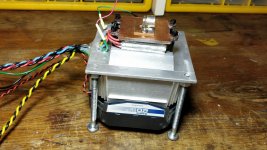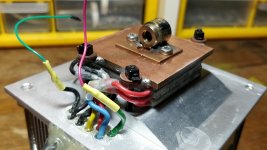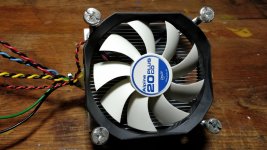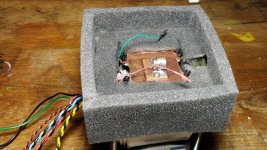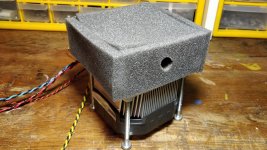Hello Guys,
now that i have finished my RGB build, i am in search for a new project.
A orange pointer comes to mind.
As anyone knows, orange and yellow is still the holy grail of a wavelength collector.
They are very expensive for low powers. One option would be DPSS (589nm or 594nm), even a PR:YLF DPSS could be made (607nm). However the crystals and output couplers are not cheap and some even need to be custom made. The alignment would also be a pain in the butt.
I did make some calculations and come up with a idea.
This would only need around 200 to 250€ worth of off-the-shelf parts, and would make up to 100mW orange.
Wheres the catch? It would even be easy to build, no real alignment needed. Just a casing that's air thight and a heatsink would be needed.
I think this could even be build to be portable or inside a (rather thick) pointer.
Some people will call me crazy, for this kind of money it can't be true.
However it IS!
I would start with this diode:
HL63163DG
Its a 100mW 633nm Ushio diode. However that's not orange.
What can we do to make it orange? External cavity? Way to complex!
A look inside the datasheet reveals a nice property of the Aluminium-gallium-indium-phosphid laser diode.
It drifts with around 0,17nm/°C!
How cold can we get it to reach something usable without resorting to liquid nitrogen or something special?
I spend a day looking at tea datasheets and 120 degree C below ambient should be reachable with around 50W- 60W of input power.
This would bring us from 25°C ambient to around -95°C. Or from 633nm to 612,6nm! (120°C * 0,17nm/°C = 20,4nm)
That should make a huge difference in perceived color.
I did try to cool a normal 638nm diode to only -45°C and it got way oranger! However this experiment only got me to around 626nm.
Thus confirming my theory.
There is only one challenge: keeping the heat out or the cold in.
I would go with a sealed case that's under vacuum. Should be easy enough to do as its only one bar that we need to keep out. This would also eliminate all condensing problems and would result in way lower thermal losses. The TEC will only pump around 0,5W at this thermal difference! So we need every bit of insulation we can get. Vacuum seems to do the job.
Costs:
Diode: 170$ at avnet, minimum purchase quantity: 10
TEC: i don't know jet, i will contact a supplier if i can get enough people interested, but i don't expect it to cost more than 100$
Output window: around 10$ for a pice of anti reflex coated glass
Collimator: same as everywhere
So we would only need to make a case, everyone with basic hand tools should be able to make one.
A vacuum pump to get the air out, a cheap one should be enough.
My question is:
Is anybody interested to order Diodes and Tecs?
If we make the parts a group buy. I think it would also be possible to do it as a "kit".
Just add your own case, and colli and enjoy the pure orange beam of your dreams!
How does that sound?
now that i have finished my RGB build, i am in search for a new project.
A orange pointer comes to mind.
As anyone knows, orange and yellow is still the holy grail of a wavelength collector.
They are very expensive for low powers. One option would be DPSS (589nm or 594nm), even a PR:YLF DPSS could be made (607nm). However the crystals and output couplers are not cheap and some even need to be custom made. The alignment would also be a pain in the butt.
I did make some calculations and come up with a idea.
This would only need around 200 to 250€ worth of off-the-shelf parts, and would make up to 100mW orange.
Wheres the catch? It would even be easy to build, no real alignment needed. Just a casing that's air thight and a heatsink would be needed.
I think this could even be build to be portable or inside a (rather thick) pointer.
Some people will call me crazy, for this kind of money it can't be true.
However it IS!
I would start with this diode:
HL63163DG
Its a 100mW 633nm Ushio diode. However that's not orange.
What can we do to make it orange? External cavity? Way to complex!
A look inside the datasheet reveals a nice property of the Aluminium-gallium-indium-phosphid laser diode.
It drifts with around 0,17nm/°C!
How cold can we get it to reach something usable without resorting to liquid nitrogen or something special?
I spend a day looking at tea datasheets and 120 degree C below ambient should be reachable with around 50W- 60W of input power.
This would bring us from 25°C ambient to around -95°C. Or from 633nm to 612,6nm! (120°C * 0,17nm/°C = 20,4nm)
That should make a huge difference in perceived color.
I did try to cool a normal 638nm diode to only -45°C and it got way oranger! However this experiment only got me to around 626nm.
Thus confirming my theory.
There is only one challenge: keeping the heat out or the cold in.
I would go with a sealed case that's under vacuum. Should be easy enough to do as its only one bar that we need to keep out. This would also eliminate all condensing problems and would result in way lower thermal losses. The TEC will only pump around 0,5W at this thermal difference! So we need every bit of insulation we can get. Vacuum seems to do the job.
Costs:
Diode: 170$ at avnet, minimum purchase quantity: 10
TEC: i don't know jet, i will contact a supplier if i can get enough people interested, but i don't expect it to cost more than 100$
Output window: around 10$ for a pice of anti reflex coated glass
Collimator: same as everywhere
So we would only need to make a case, everyone with basic hand tools should be able to make one.
A vacuum pump to get the air out, a cheap one should be enough.
My question is:
Is anybody interested to order Diodes and Tecs?
If we make the parts a group buy. I think it would also be possible to do it as a "kit".
Just add your own case, and colli and enjoy the pure orange beam of your dreams!
How does that sound?




